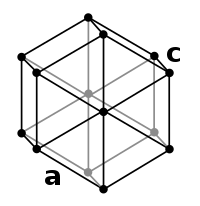
Photo from wikipedia
In this paper, we study the influence of hydrogen concentration on the binding energies in magnesium hydrides. The impact of aluminum atom addition on the hydrogenation behavior of magnesium was… Click to show full abstract
In this paper, we study the influence of hydrogen concentration on the binding energies in magnesium hydrides. The impact of aluminum atom addition on the hydrogenation behavior of magnesium was theoretically and experimentally defined. Doping Al into the Mg lattice allows the uniform hydrogen distribution in both the fcc and bcc Mg lattice at a low hydrogen concentration (H:Mg < 0.875) to be more energetically favorable. In addition, this leads to bcc Mg lattice formation with a uniform hydrogen distribution, which is more energetically favorable than the fcc Mg lattice when the atomic ratio H:Mg is near 0.875. In addition, compared with the pure Mg, in the Al-doped Mg, the phase transition from the hcp to the fcc structure with a uniform distribution of H atoms induces less elastic strain. Thus, the uniform hydrogen distribution is more favorable, leading to faster hydrogen absorption. Pure magnesium is characterized by cluster-like hydrogen distribution, which decreases the hydrogen diffusion rate. This leads to the accumulation of a higher hydrogen concentration in magnesium with aluminum compared with pure magnesium under the same hydrogenation regimes, which is confirmed experimentally.
Journal Title: Materials
Year Published: 2022
Link to full text (if available)
Share on Social Media: Sign Up to like & get
recommendations!